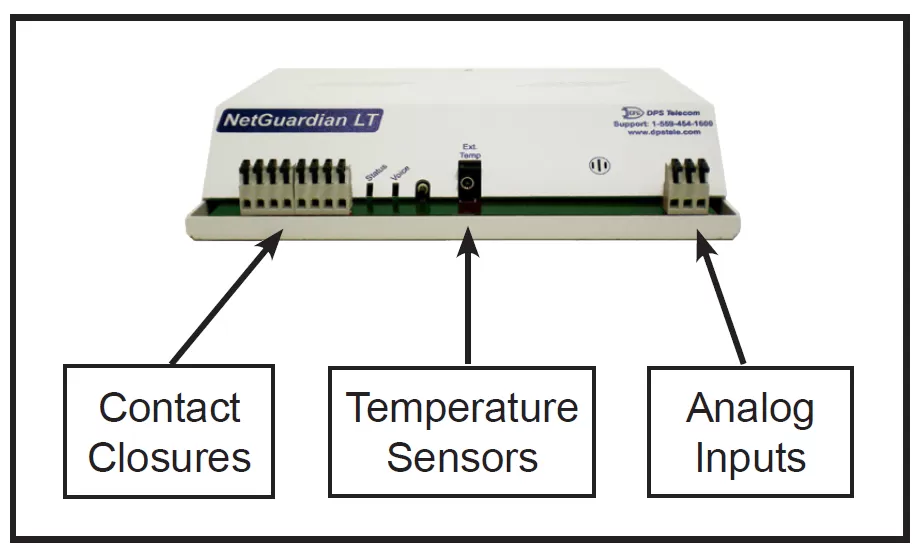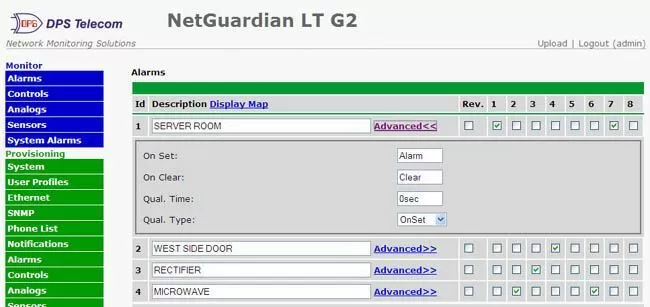Check out our White Paper Series!
A complete library of helpful advice and survival guides for every aspect of system monitoring and control.
1-800-693-0351
Have a specific question? Ask our team of expert engineers and get a specific answer!
Sign up for the next DPS Factory Training!

Whether you're new to our equipment or you've used it for years, DPS factory training is the best way to get more from your monitoring.
Reserve Your Seat TodayMost companies that depend on a remote network located across any number of distant sites have to know when problems happen. After all, these issues will affect the company's service reliability and bottom line.
For this reason, many industries deploy remote monitoring systems. These systems alert techs about issues as soon as they happen. The way teams are notified will vary depending on what's best for their scenario. Many techs prefer receiving phone calls because they tend to draw more attention than an email would.
Auto-dialers are great for this specific task. They will monitor your sites 24x7 and they'll call you when problems are detected. But, you can't simply buy any device - it's critical that you know you're deploying a high-quality unit.
As a trusted remote monitoring solutions provider, we understand how important it is for you to be able to tell the difference between reliable industrial-grade gear and cheap "bare minimum" dialers. So, this article will help you with your research.

Auto-dialers are remote monitoring devices that work by detecting problems at your remote sites and calling one or more pre-configured phone numbers to report those issues.
If you have one site or just a few small sites, there's really no need for a central master station to collect incoming alarms because alarm information will be delivered directly to you over the phone. However, if your site count grows large enough that you need a master station to collect and manage alarms, a competent auto-dialer will support that change, but it's usually not a requirement from Day 1.
But how do auto-dialers collect alarms? Before you can receive alarm notifications, you have to set up your auto-dialers to detect problems at your remote sites. This can take a few forms:

Contact closure inputs can also be called discrete alarms or digital inputs. A contact closure is a simple on/off switch that, when activated by the device, closes a path that allows electrical current to flow through the auto-dialer's input. This current flow is detected as an alarm.
Contact closures are the simplest kind of alarm input, so they're often used as a kind of lowest-common-denominator means of getting some kind of alarm from any kind of equipment.
It's important for an auto-dialer to accept contact closures because they're so common, but you also need other kinds of inputs to get the complete picture. One really easy way to do this is to purchase an auto-dialer with an internal analog temperature sensor.
This type of auto-dialer has an embedded sensor that reports the real-time temperature measured from within its own chassis. Because the sensor is integrated inside the unit itself, there's no wiring or setup required. The sensor begins monitoring the internal temperature as soon as you turn on your auto-dialer.
Monitoring temperature at your sites is critical because high heat can damage or even destroy equipment. Imagine what would happen if your servers were damaged by heat. That would create a lot of extra costs and network downtime.
However, you need to be careful when evaluating your options from vendors. Some dialers only simulate analog temperature monitoring with a "threshold" alarm. With threshold alarms, you only know that the temperature is over some arbitrary value. You might get an alarm message that the temperature is "over 90 degrees" (which could be 91 degrees or 191 degrees). You'll have no way of getting an accurate, real-time temperature reading.
This type of temperature sensor is identical to the internal sensor we've talked about, but there's a critical difference: you are not limited to measuring the temperature within the auto-dialer itself.
Temperature can vary significantly at different areas within the same site. What if you have a particular piece of equipment that "runs hot" and you want to monitor it closely? By the time that device heated the whole room enough to trigger your auto-dialer's internal sensor, it would probably be seconds from failing.
This is when having an external temperature sensor probe on a long wire becomes absolutely important. A length of bout seven feet is right for most applications, but a good vendor will be able to accommodate a different length if you need it.
Also, make sure that the sensor plugs into your auto-dialer with a single click. This way, you'll avoid wasting your time with complicated installations.
Having precise analog measurement and user-configurable threshold alarms for monitoring temperature is critical. You've got to be able to get a precise reading at any time, and you need to receive automatic alerts if the temperature goes beyond your specified tolerance.
General purpose analog inputs take the same concepts to their important values besides the temperature. Think about your sites where you need to monitor humidity, power and battery voltages, fuel levels, water levels, and other important values that just can't be represented by a simple "yes" or "no". You need an actual, physical measurement of these conditions in real-time.
This is where general-purpose analog inputs become important. An analog input itself consists of just 2 wire terminals (positive and negative). The best inputs can be configured to monitor either the voltage from -92vdc to +92vdc or the current (4 to 20mA) flowing through them.
If you want to monitor a value that's already in voltage or current form, like the voltage from a site battery that indicates the remaining charge, you don't need anything else. You'll just wire it directly into your auto-dialer's analog input.
But, if you want to monitor a different kind of value, such as humidity or fuel tank level, you'll purchase a small analog sensor that you can wire into your auto-dialer. As far as your auto-dialer is concerned, it's still just monitoring voltage or current. The external sensor acts as an intermediary, converting the sensor's measurements into voltage/current output. The most common sensors output 0-5vdc or 4-20mA.
This conversion from "native units" like percentage humidity or fuel remaining to "electrical units" like voltage or current does highlight one important auto-dialer feature. You want o find an auto-dialer that will translate the incoming voltage/current back into native units before notifying you.
Do you want to receive a phone call that says "your current site humidity is 2.7 volts"? Probably not. So, your auto-dialer should be able to convert "2.7 volts" to the much more relevant "65% relative humidity".
There are quite a few auto-dialer models to choose from. Some are good. Some aren't so good. The following are important features that efficient devices have.
Also, one important thing to keep in mind when you're evaluating auto-dialers, make sure to consider how much time it will take to setup. Efficient devices can be up and running very quickly.
One key factor that affects setup time is the user interface. Many auto-dialers come with a clunky audio-only interface. That kind of thing is fine during a phone call, but there's really no excuse for it during the initial setup phase.
One excellent way to make your setup time as short as possible is to purchase an auto-dialer with a built-in web interface. That allows you to configure the unit on your computer screen - all without installing any special software. In this case, being able to see all of the configuration options is a big help. It's many times better than "Press 9 to hear more options..."

Although efficient and still useful in some cases, receiving notifications through phone lines is becoming less and less common. So, having a plan to transition to other communication transports, such as LAN, is key.
Also, efficient auto-dialers usually last for at least 15 years, so ideally your chosen device should have multiple transport options. This way, you can modernize your network and while being able to keep your still operational device.
Since auto-dialers are some of the most basic monitoring devices, many manufacturers use them as a starting point for their businesses. This is something you need to be very careful about.
It's not that companies who start out with auto-dialers are necessarily trying to cheat you. It just means that you're buying one of their first few attempts at delivering a quality product. Even if they've recently moved on to more complex gear, they probably haven't gone back to update their early auto-dialers with new technology.
It may seem ironic, but the best auto-dialers come from manufacturers that started their businesses by developing monitoring systems for major corporations, national governments, and military agencies. To survive in these markets for long, a vendor has to constantly improve their product designs to increase reliability in complex networks and harsh environmental conditions.
For example, when we started developing auto-dialers for the first time, the quality we've been honing for years gets included automatically. We don't even think about it. Since we're used to pleasing huge clients, delivering top-notch quality every time is just business as usual.
So, when you're buying an auto-dialer, you will have two main options:
Choosing between these two options is a no brainer. But, as you evaluate your auto-dialer options, ask your vendors this tough question: "What names on your client list will prove to me that your auto-dialer will survive at my sites?"
If a manufacturer can't give you any known names, can you really trust the reliability of their gear? Ask tough questions to protect yourself from equipment that doesn't perform as advertised.
The NetGuardian LT G2 is a reliable, cost-effective auto-dialer for small sites. It primarily reports alarms over LAN, but it also features backup transport over POTS.
With the LT G2, you can choose how you will receive your alerts - via phone or SNMP. This means that you can receive custom voice alerts to your phone and/or have your alerts sent to your SNMP manager as trap messages.
This monitoring unit is based on the time-tested design of our high-capacity devices. The LT G2 has a durable aluminum chassis that can be rack or wall-mounted.

Determining your alarm monitoring needs can be tough. Trying to evaluate auto-dialer devices and survey your remote sites can be difficult when you still have all your job responsibilities to take care of.
So, why not get help from experts you can trust? We will help you survey your remote sites step-by-step, making sure you don't miss any opportunities to make your network monitoring project successful - and easier on your budget.
One of our experts will help you figure out what monitoring products will most effectively meet your needs without overloading your budget. Our goal is to give you the tools you need to help keep your network up and running.
Reach out to us for your no-obligation consultation.

Morgana Siggins
Morgana Siggins is a marketing writer, content creator, and documentation specialist at DPS Telecom. She has created over 200 blog articles and videos sharing her years of experience in the remote monitoring industry.